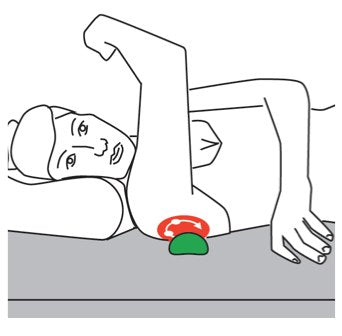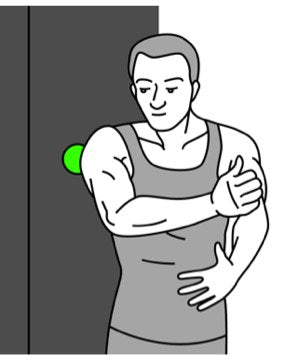Trigger Point Therapy | Thoracic Outlet Syndrome
Treating Thoracic Outlet Syndrome
Thoracic outlet syndrome (TOS) is a frequently overlooked peripheral nerve compression or tension event that is often difficult to diagnose - but can often respond surprisingly fast to manual therapy
TOS occurs when nerves and/or blood vessels become compressed in their passageway through the thoracic outlet which sits between your collarbone and first rib.
The thoracic outlet is surrounded by bone, muscle and other tissues. Movement or enlargement of these tissues near the thoracic outlet as a result of conditions such as cervical rib, tumors in the chest, muscle enlargement and weight gain, may lead to TOS.
These conditions may cause the collarbone to slip putting pressure on the blood vessels and nerves that sit underneath it leading to TOS.
TOS Awareness
TOS is one of a group of conditions that cause pain into the arm hand and fingers.
Not everyone is too aware of TOS and it's not unusual for clients to work their way through a number of visits to doctors and therapists by the time they receive a confirmed TOS diagnosis.
Types of TOS
The symptoms of TOS can be really disturbing and cause much anxiety (which doesn’t help).
There are generally two types of TOS – one is an unmistakable blockage pressure (organic) to the nerves or blood supply and the other is a functional or temporary pressure issue.
This functional group tends to respond very well to trigger point self-help techniques.
That’s because functional TOS results from a combination of poor rib mechanics and tight muscles (especially the Scalenes and Pectoralis Minor) that cause pressure on the neurovascular structures (sometimes called a myogenic plexopathy).
What Are the Symptoms of Thoracic Outlet Syndrome?
This will depend on the blood vessels or nerves that are compressed. It is more common to have symptoms from nerve compression than from blood vessel compression.
- Both types of compression may make overhead activities difficult.
- Discoloration or swelling in your arm.- Depression in your shoulder.
- Limited range of motion.
- Redness or swelling of the arm due to a reduction in the blood flow from pressure on the blood vessels. Symptoms may also be felt in the arm and hand.
- A dull ache from nerve pressure may be felt in the hand, arm, shoulder or neck. Tingling, pain or numbness may also be felt on the inside of the forearm and 4th and 5th fingers . The hand may feel clumsy.

Who is Prone to Thoracic Outlet Syndrome?
- Physically active, younger adults whose occupations involve repetitive raising of the arms e.g. machine operators, truck drivers and dental workers
- Those born with an extra rib (known as cervical rib)- Those with deformity resulting from a fracture to the first rib or collarbone
- Older people - sagging of the shoulder
Differential Diagnosis - What Else Could It Be?
Here is a list of other conditions which can present as thoracic outlet syndrome; some of them can be serious, so if you are concerned please check with your doctor or therapist:
-
Extra cervical rib or ligamentous (false) rib
-
Pancoast tumor
-
Brachial plexopathy – infective or traumatic
-
So tissue damage (from a whiplash)
-
Heart attack (le side)
-
Vertebral artery disease or aneurism
-
Hyperkyphosis or scoliosis of the thoracic spine
-
Neck degenerative changes, cervical bars and osteophytes
-
Radial Neuropathy
-
Syringomyelia
-
Complex Regional Pain Syndrome 1(CRPS1) - RSD
-
Problems (age related) with the neck including discs and spinal joints
-
Ankylosing spondylitis
-
Median neuropathy
-
Ulnar neuropathy
TOS and Trigger Point Therapy
Trigger points can develop in muscles for a number of reasons especially overuse.
When present, trigger points cause the host muscle to be shorter, tighter and tenser and they also add to the cycle of increased input to the peripheral and central nervous system.
With TOS, the results of trigger point therapy can be startlingly fast; will almost always provide relief; and accelerate well being.
As is usually the case with trigger point therapy, the hands-on treatment is likely to be most effective when combined with correct stretching and strengthening exercises.
When treating TOS, these typically include neck stretching, ulnar glides, upper trapezius and pectoralis stretching, back mobilization, and rhomboid strengthening.
Self treatment with pressure tools can also be very effective. See examples below:

Self Help - Subclavius

Self Help - Infraspinatus

Self Help - Infraspinatus

Self Help - Pectoralis Minor
This blog is intended to be used for information purposes only and is not intended to be used for medical diagnosis or treatment or to substitute for a medical diagnosis and/or treatment rendered or prescribed by a physician or competent healthcare professional. This information is designed as educational material, but should not be taken as a recommendation for treatment of any particular person or patient. Always consult your physician if you think you need treatment or if you feel unwell.
About Niel Asher Education
Niel Asher Education (NAT Global Campus) is a globally recognised provider of high-quality professional learning for hands-on health and movement practitioners. Through an extensive catalogue of expert-led online courses, NAT delivers continuing education for massage therapists, supporting both newly qualified and highly experienced professionals with practical, clinically relevant training designed for real-world practice.
Beyond massage therapy, Niel Asher Education offers comprehensive continuing education for physical therapists, continuing education for athletic trainers, continuing education for chiropractors, and continuing education for rehabilitation professionals working across a wide range of clinical, sports, and wellness environments. Courses span manual therapy, movement, rehabilitation, pain management, integrative therapies, and practitioner self-care, with content presented by respected educators and clinicians from around the world.
Known for its high production values and practitioner-focused approach, Niel Asher Education emphasises clarity, practical application, and professional integrity. Its online learning model allows practitioners to study at their own pace while earning recognised certificates and maintaining ongoing professional development requirements, making continuing education accessible regardless of location or schedule.
Through partnerships with leading educational platforms and organisations worldwide, Niel Asher Education continues to expand access to trusted, high-quality continuing education for massage therapists, continuing education for physical therapists, continuing education for athletic trainers, continuing education for chiropractors, and continuing education for rehabilitation professionals, supporting lifelong learning and professional excellence across the global therapy community.

Continuing Professional Education
Looking for Massage Therapy CEUs, PT and ATC continuing education, chiropractic CE, or advanced manual therapy training? Explore our evidence-based online courses designed for hands-on professionals.


















